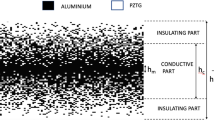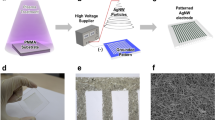Abstract
We present a shape design optimization method for interdigitated electrodes in an electro-adhesive device. In the finite element analysis of electrostatics using linear basis functions, a finite node displacement method is used for the accurate electro-adhesive force by integrating the electric field along the boundary surface. The floating potential boundary for conductive objects is handled by a charge conservation law in the electrostatic analysis as well as the shape design sensitivity analysis. In numerical examples, the structural shape of interdigitated electrodes is optimized to maximize the electro-adhesion force per unit area for both conductive and non-conductive objects. It turns out that the electro-adhesive force is mainly induced by an electrostatic induction for conductive objects and by an electric polarization for non-conductive ones. There is an optimal ratio of electrode width and air gap thickness for non-conductive objects but no limit for conductive objects.















Similar content being viewed by others

References
Akherat SJM, Karimi MA, Alizadehyazdi V, Asalzadeh S, Spenko M (2019) A tunable dielectric to improve electrostatic adhesion in electrostatic/microstructured adhesives. J Electrost 97:58–70
Atkinson R (1969) A simple theory of the johnsen-rahbek effect. J Phys D Appl Phys 2(3):325
Bamber T, Guo J, Singh J, Bigharaz M, Petzing J, Bingham PA, Justham L, Penders J, Jackson M (2017) Visualization methods for understanding the dynamic electroadhesion phenomenon. J Phys D Appl Phys 50(20):205,304
Cao C, Sun X, Fang Y, Qin QH, Yu A, Feng XQ (2016) Theoretical model and design of electroadhesive pad with interdigitated electrodes. Materials & Design 89:485–491
Choi KK, Chang KH (1994) A study of design velocity field computation for shape optimal design. Finite Elem Anal Des 15(4):317–341
Choi KK, Kim NH (2006) Structural sensitivity analysis and optimization 1: linear systems. Springer Science & Business Media, Berlin
Dadkhah M, Ruffatto D III, Zhao Z, Spenko M (2018) Increasing adhesion via a new electrode design and improved manufacturing in electrostatic/microstructured adhesives. J Electrost 91:48–55
Delfino F, Rossi M (2002) A new fem approach for field and torque simulation of electrostatic microactuators. Journal of Microelectromechanical Systems 11(4):362–371
Gilbarg D, Trudinger NS (2015) Elliptic partial differential equations of second order. Springer, Berlin
Guo J, Bamber T, Chamberlain M, Justham L, Jackson M (2016) Optimization and experimental verification of coplanar interdigital electroadhesives. J Phys D Appl Phys 49(41):415,304
Guo J, Bamber T, Hovell T, Chamberlain M, Justham L, Jackson M (2016) Geometric optimisation of electroadhesive actuators based on 3d electrostatic simulation and its experimental verification. IFAC-PapersOnLine 49(21):309–315
Ilinca F, Pelletier D (2007) Computation of accurate nodal derivatives of finite element solutions: the finite node displacement method. Int J Numer Methods Eng 71(10):1181–1207
Koh K, Sreekumar M, Ponnambalam S (2014) Experimental investigation of the effect of the driving voltage of an electroadhesion actuator. Materials 7(7):4963–4981
Mao JB, Qin L, Zhang WX, Xie L, Wang Y (2015) Modeling and analysis of electrostatic adhesion force for climbing robot on dielectric wall materials. European Phys J Appl Phys 69(1):11,003
Monkman G (2003) Electroadhesive microgrippers. Industrial Robot: An International Journal
Monkman GJ (1997) An analysis of astrictive prehension. Int J Robotics Res 16(1):1–10
Prahlad H, Pelrine R, Stanford S, Marlow J, Kornbluh R (2008) Electroadhesive robots—wall climbing robots enabled by a novel, robust, and electrically controllable adhesion technology. In: 2008 IEEE international conference on robotics and automation. IEEE, pp 3028–3033
Ruffatto D, Shah J, Spenko M (2013) Optimization and experimental validation of electrostatic adhesive geometry. In: 2013 IEEE aerospace conference. IEEE, pp 1–8
Sabermand V, Hojjat Y, Hasanzadeh M (2014) Study of parameters affecting the electrostatic attractions force. Int J Mech Mech Eng 8(11):1797–1800
Téllez JPD, Krahn J, Menon C (2011) Characterization of electro-adhesives for robotic applications. In: 2011 IEEE international conference on robotics and biomimetics. IEEE, pp 1867–1872
Velev OD, Gangwal S, Petsev DN (2009) Particle-localized ac and dc manipulation and electrokinetics. Annual Reports Section C(Physical Chemistry) 105:213–246
Yoon GH, Park J (2010) Topological design of electrode shapes for dielectrophoresis based devices. J Electrost 68(6):475–486
Funding
This work was supported by the Technology Development Program (S2591643) funded by the Ministry of SMEs and Startups (MSS, Korea). The support is gratefully acknowledged.
Author information
Authors and Affiliations
Corresponding author
Ethics declarations
Conflict of interests
The authors declare that there is no conflict of interest between the authors and the funder.
Additional information
Responsible Editor: Emilio Carlos Nelli Silva
Publisher’s note
Springer Nature remains neutral with regard to jurisdictional claims in published maps and institutional affiliations.
Replication of results
All the expressions are implemented using FORTRAN and the resulting data are processed by Techplot. The processed data used to support the findings of this study are available from the corresponding author upon request. If the information provided in the paper is not sufficient, interested readers are welcome to contact the authors for further explanations.
Rights and permissions
About this article
Cite this article
Kim, JH., Kang, SH. & Cho, S. Shape design optimization of interdigitated electrodes for maximal electro-adhesion forces. Struct Multidisc Optim 61, 1843–1855 (2020). https://doi.org/10.1007/s00158-020-02576-6
Received:
Revised:
Accepted:
Published:
Issue Date:
DOI: https://doi.org/10.1007/s00158-020-02576-6



